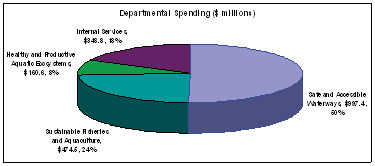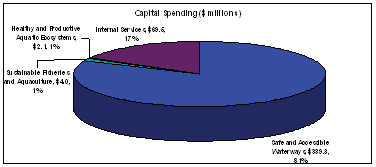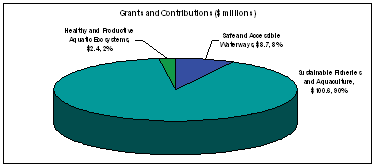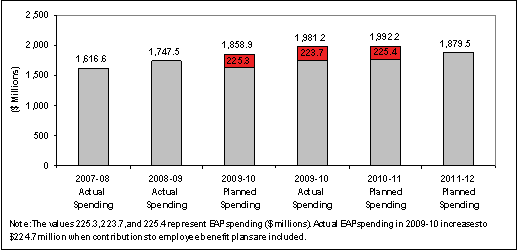Minister's Message

As Minister of Fisheries and Oceans, I am pleased to present to Parliament and Canadians the 2009-10 Departmental Performance Report for Fisheries and Oceans Canada (DFO).
DFO and the Canadian Coast Guard (CCG), a Special Operating Agency within DFO, use sound management practices and science-based decision-making to provide services and benefits to Canadians through three strategic outcomes: Safe and Accessible Waterways, Sustainable Fisheries and Aquaculture, and Healthy and Productive Aquatic Ecosystems.
In 2009-10, DFO focused on a number of important areas, including the following, to achieve these three outcomes.
Delivering on Projects under the Economic Action Plan
Under Canada's Economic Action Plan, we have been making strategic investments that create jobs and help revitalize communities.
With a two-year, $175 million commitment, we are modernizing DFO's fleet by procuring 68 new small vessels and 30 environmental barges, and performing repair work on 40 aging large vessels.
We are investing $200 million over two years to accelerate the maintenance and repair of fishing harbours across Canada, with work either completed or under way in many coastal areas. In addition, we are investing $17 million to accelerate the construction of a commercial fishing harbour in Pangnirtung, Nunavut, to boost the viability of the Northern fishery.
We are investing $37 million over two years to modernize DFO's laboratories and science facilities and $65 million to help the lobster fishery weather short-term challenges and to thrive in the future.
Improving the Economic Viability of Canada's Fisheries
We are working closely with industry stakeholders to help them obtain the certification needed to expand access to markets at home and abroad. I am pleased to report that in December 2009, DFO opened its first Catch Certification Office to support Canadian exports of fish and seafood products affected by European Union regulatory requirements. I also visited China last year to promote Canadian seal products and seafood to the world's largest consumer of fish and seafood.
Commission of Inquiry into the Decline of Sockeye Salmon in the Fraser River
In November 2009, the Government of Canada took action to address the low returns of sockeye salmon to the Fraser River by establishing the Commission of Inquiry into the Decline of Sockeye Salmon in the Fraser River. DFO recognizes the importance of this iconic species to all sectors of the fishery, the British Columbia economy, and all Canadians, and has been working to fully support the Commission and its efforts.
Improving the Health of the Oceans
The Government of Canada has completed the third year of a five-year multi-departmental commitment to protect sensitive areas, control ocean pollution, and ensure collaborative oceans management.
As we look to the future, we will continue to consult with stakeholders, using science and the public interest as the foundation of our work and our decision-making. The world around us is constantly changing, and DFO is adapting to deliver excellent results for Canadians every step of the way.
The Honourable Gail Shea, P.C, M.P.
Minister of Fisheries and Oceans
Section 1 - Departmental Overview
Raison d'etre
Fisheries and Oceans Canada (DFO) plays the lead role in managing Canada's fisheries and safeguarding its waters, ensuring safe, healthy, and productive waters and aquatic ecosystems for the benefit of present and future generations. The Department's work is built around three strategic outcomes:
Safe and Accessible Waterways
- Providing access to Canadian waterways and ensuring the overall safety and integrity of Canada's marine infrastructure for the benefit of all Canadians;
Sustainable Fisheries and Aquaculture
- Delivering an integrated fisheries and aquaculture program that is credible, science-based, affordable, and effective and contributes to sustainable wealth for Canadians while respecting Aboriginal and treaty rights; and
Healthy and Productive Aquatic Ecosystems
- Ensuring the sustainable development and integrated management of resources in or around Canada's aquatic environment and carrying out critical science and fisheries management activities.
Mandate
DFO is responsible for developing and implementing policies and programs in support of Canada's scientific, ecological, social, and economic interests in oceans and fresh waters.
The Canadian Coast Guard (CCG), a Special Operating Agency within DFO, is responsible for services and programs that contribute to the safety, security, and accessibility of Canada's waterways. DFO supports other government organizations through the provision of a civilian fleet and a broadly distributed shore-based infrastructure.
Our Vision
Excellence in service to Canadians to ensure the sustainable development and safe use of Canadian waters.
The Canadian Coast Guard (CCG), a Special Operating Agency within DFO, is responsible for services and programs that contribute to the safety, security, and accessibility of Canada's waterways. DFO supports other government organizations through the provision of a civilian fleet and a broadly distributed shore-based infrastructure.
The Oceans Act entrusts the Minister with leading integrated oceans management and providing coast guard and hydrographic services, while the Fisheries Act gives the Minister responsibility for the management of fisheries, habitat, and aquaculture. The Species at Risk Act gives the Minister responsibilities associated with the management of aquatic species at risk.
Organization
Fisheries and Oceans Canada is a highly decentralized department, with more than eight of every ten employees working outside national headquarters in one of its six regions. National objectives, policies, procedures, and standards for the Department and DFO are established at national headquarters, in Ottawa. Regions are responsible for delivering programs and activities in accordance with national and regional priorities and within national performance parameters.
Information about DFOs regions, Canadian Coast Guard, and DFO's organizational structure is available electronically on DFO's website.
Operating Environment
Canada is a maritime nation, with three oceans bordering its coastline (the world's longest) and lakes and rivers that make up the world's largest freshwater ecosystem. Together, the country's aquatic resources offer countless economic, cultural, social, and environmental benefits to Canadians.
DFO is responsible for developing and implementing policies and programs in support of Canada's scientific, ecological, social, and economic interests in these aquatic resources. In so doing, DFO must strike a balance between environmental stewardship and economic prosperity while recognizing the interests of various stakeholders and complex ecological factors.
Today, both fundamental long-term changes and recent events are creating challenges and opportunities for DFO and its clients/stakeholders.
On the economic front, the recent recession has driven down prices and global demand for fish and seafood. The high Canadian dollar and higher input costs have increased pressure on the sector, and the profits of commercial fishers have declined dramatically. Competition from the fisheries of developing countries is also becoming more intense.
International markets are increasing their demands for proof that fish and seafood were caught in a legal and sustainable manner. In fact, Canadian products risk being shut out of markets if they are unable to meet rising expectations for sustainability, quality, and food safety. Environmental organizations are focusing more and more on the marine environment, and DFO's management practices in this area are undergoing greater scrutiny.
Social changes are further affecting the fishing sector. Significant demographic shifts are occurring in traditional fishing communities, with younger generations turning away from fishing and toward industries not found in coastal communities. This is hollowing out such communities and creating additional challenges for those who remain in the sector.
The changing environment is providing both challenges and opportunities for the management of Canada's aquatic resources. On the one hand, our natural assets are being put at risk by ocean acidification and warming waters; pollution from development, spills, and accidents; and the growing number of aquatic invasive species. On the other hand, the extraction of new natural resources, the development of Aboriginal and commercial fisheries, and the growth of the tourism industry are all increasing our economic potential, especially in the North.
Although managing wild commercial fisheries has been the Department's traditional focus, aquaculture now accounts for one-third of the total value of Canada's marine harvest. Other marine industries are developing, ecotourism and recreational fisheries are growing, and the ocean economy is broadening as ocean technologies advance. The future may bring new economic opportunities to fisheries communities, but it may also bring greater demand for access to ocean resources for offshore oil and gas exploration, renewable offshore energy, and marine transportation activities.
Summary of Financial and Human Resources
| Planned Spending | Total Authorities | Actual Spending |
|---|---|---|
| 1,858.9 | 2,049.0 | 1,981.2 |
| Planned | Actual | Variance |
|---|---|---|
| 10,808 | 11,030 | 222 |
Program Activity Architecture
The Government of Canada's Management, Resources and Results Structure (MRRS) is the foundation of a common, government-wide approach to the collection, management, and reporting of financial and non-financial information. DFO's Program Activity Architecture (PAA) is a component of its MRRS. The PAA shows how DFO's programs align with the Department's three strategic outcomes. Each Program Activity within a Strategic Outcome is linked to a single Government of Canada Outcome Area, permitting whole-of-government reporting. The PAA also includes a standalone Program Activity called Internal Services, defined as the activities and resources that support an organization's program needs and other corporate obligations. For more information on DFO's Internal Services, see Internal Services.

Fisheries and Oceans Canada's Program Activity Architecture
Planning Summary by Strategic Outcome1
| Performance Indicator | Target | Summary of Performance |
|---|---|---|
| Public's confidence of the safety and security of marine travel in Canada | 90% | This result was to be derived from a Transport Canada survey of public opinion. However, because of a moratorium on syndicated studies pending centralized negotiations between Public Works and Government Services Canada and private-sector contractors, DFO was not able to evaluate its 2009-10 performance on this expected result. |
| Program Activity | Alignment to Government of Canada Outcome Area | 2008-09 | 2009-10 | |||
|---|---|---|---|---|---|---|
| Actual Spending | Main Estimates | Planned Spending | Total Authorities | Actual Spending | ||
| Canadian Coast Guard | Safe and secure Canada | 709.6 | 585.0 | 701.1 | 734.2 | 736.1 |
| Small Craft Harbours | Strong economic growth | 119.8 | 92.8 | 192.8 | 216.9 | 221.0 |
| Science for Safe and Accessible Waterways | Innovative and knowledge-based economy | 52.0 | 35.3 | 35.3 | 40.5 | 40.2 |
| Total | 881.3 | 713.1 | 929.2 | 991.6 | 997.4 | |
Note: Because of rounding, figures may not add to the totals shown.
| Performance Indicator | Target | Summary of Performance |
|---|---|---|
| Year over year improvement in management and conservation of major stocks to support sustainable fisheries, as evidenced in growth of the sustainability index (baseline 5.4 out of 10) | 4% | Sustainability index: 5.4 (data is from 2008-09, as 2009-10 data has not yet been compiled). |
| Program Activity | Alignment to Government of Canada Outcome Area | 2008-09 | 2009-10 | |||
|---|---|---|---|---|---|---|
| Actual Spending | Main Estimates | Planned Spending | Total Authorities | Actual Spending | ||
| Fisheries and Aquaculture Management | Strong economic growth | 409.1 | 330.4 | 331.6 | 366.2 | 339.6 |
| Science for Sustainable Fisheries and Aquaculture | Innovative and knowledge-based economy | 225.6 | 139.7 | 139.7 | 150.2 | 134.9 |
| Total | 634.8 | 470.1 | 471.3 | 516.4 | 474.5 | |
Note: Because of rounding, figures may not add to the totals shown.
| Performance Indicator | Target | Summary of Performance |
|---|---|---|
| Number of policies developed and implemented that serve the public interest via the sustainable development of Canada's oceans and freshwater resources | 18 Habitat policies 5 Species at Risk policies |
|
| Number of programs in place that serve the public interest via the sustainable development of Canada's oceans and freshwater resources | 8 Habitat programs 3 Oceans programs 1 Species at Risk program |
|
| Number of formal partnership arrangements established that serve the public interest via the management of human activities in and around aquatic ecosystems | 18 national-level partnerships on the management of fish habitat 1 Oceans management partnership 4 Species at Risk management partnerships |
|
| Program Activity | Alignment to Government of Canada Outcome Area | 2008-09 | 2009-10 | |||
|---|---|---|---|---|---|---|
| Actual Spending | Main Estimates | Planned Spending | Total Authorities | Actual Spending | ||
| Oceans Management | Clean and healthy environment | 21.1 | 16.4 | 16.4 | 17.4 | 15.8 |
| Habitat Management | Clean and healthy environment | 124.2 | 57.7 | 57.7 | 65.0 | 62.0 |
| Species at Risk Management | Clean and healthy environment | n/a | 16.9 | 16.9 | 18.6 | 21.8 |
| Science for Healthy and Productive Aquatic Ecosystems | Innovative and knowledge-based economy | 86.2 | 55.4 | 55.4 | 61.4 | 60.9 |
| Total | 231.4 | 146.4 | 146.4 | 162.3 | 160.6 | |
Note: Because of rounding, figures may not add to the totals shown.
|
|
2008-09 | 2009-10 | ||||
|---|---|---|---|---|---|---|
| Actual Spending | Main Estimates | Planned Spending | Total Authorities | Actual Spending | ||
| Safe and Accessible Waterways | 881.3 | 713.1 | 929.2 | 991.6 | 997.4 | |
| Sustainable Fisheries and Aquaculture | 634.8 | 470.1 | 471.3 | 516.4 | 474.5 | |
| Healthy and Productive Aquatic Ecosystems | 231.4 | 146.4 | 146.4 | 162.3 | 160.6 | |
| Internal Services | n/a2 | 311.9 | 311.9 | 378.8 | 348.8 | |
| Total Departmental Spending | 1,747.5 | 1,641.5 | 1,858.9 | 2,049.0 | 1,981.2 | |
Note: Because of rounding, figures may not add to the totals shown.
Departmental Priorities
DFO focused on a number of operational and management priorities in 2009-10. Descriptions for each of the priorities and the key plans for 2009-10 can be found in the 2009-10 Report on Plans and Priorities. Each priority has been assigned an overall performance rating based on the following:
| If this percentage of expected performance is achieved | The performance rating is defined as | The performance rating is shown graphically as |
|---|---|---|
| More than 100% | Exceeded | ✰✰✰ |
| 100% | Met All | ✔✔✔ |
| 80 to 99% | Mostly Met | ✔✔— |
| 60 to 79% | Somewhat Met | ✔—— |
| Less than 60% | Not Met | ——— |
Contribution of Operational Priorities to Strategic Outcomes
Fisheries Renewal
Performance Rating: ✔✔—
- Sustainable Fisheries and Aquaculture
Type: Ongoing
Key Accomplishments
- Introduced the Atlantic Lobster Sustainability Measures program, and developed and implemented the Short-term Transitional Measures program.
- Supported the development of a new Lobster Council of Canada.
- Initiated a process for reforming the national licensing policy.
- Improved fishers' access to capital.
- Developed a transparent process for stabilizing sharing arrangements.
- Developed and initiated pilots of the Consultation Management Tool, which facilitates internal and external consultation.
- Improved the Fisheries Checklist template and analyzed the data for approximately 120 commercial fish stocks to determine sustainability.
- Developed working groups on many levels to actively engage stakeholders in discussion and policy development.
- Worked with the Habitat Management Program to revise the National Habitat Compliance Protocol.
- Developed and delivered training on a new risk-based Habitat Compliance Decision Framework.
Northern Strategy
Performance Rating: ✔✔✔
- All Strategic Outcomes
Type: Previously committed to
Key Accomplishments
- Received Preliminary Project Approval for a new polar icebreaker from Treasury Board in June 2009, completed an assessment of procurement options, and started preliminary conceptual design work. The project remains on schedule.
- Started to build a small craft harbour in Pangnirtung, Nunavut.
- Started to develop a strategic approach to hiring in the North.
- Collected about 75% of the total planned data for Canada's submission to the United Nations Commission on the Limits of the Continental Shelf, which must be made in 2013. Data collection in the Arctic has been more complicated and time consuming than anticipated, largely because of weather and changing and unstable ice conditions.
- Contributed to the process of establishing a world-class Arctic research facility.
- Provided input to Indian and Northern Affairs Canada on its plans to accelerate the review of resource projects in the North.
- Provided input into the drafting of the proposed Nunavut Project Planning and Assessment Act. The legislation is a requirement of the Nunavut Land Claims Agreement and would create additional certainty about regulatory processes in the Territory.
- Completed field-based research on the impacts of climate variability and change on Arctic marine ecosystems.
International Agenda
Performance Rating: ✔✔✔
- Sustainable Fisheries and Aquaculture
- Healthy and Productive Aquatic Ecosystems
Type: Ongoing
Key Accomplishments
- Ratified an amended Convention for the Northwest Atlantic Fisheries Organization (NAFO), which will enable improved fisheries-management decision-making when it comes into force. Departmental scientists also led the assessment of over half of all fisheries stocks managed by NAFO.
- Played a leadership role at the Food and Agriculture Organization of the United Nations (FAO) in adopting a legally binding instrument to set a global standard for port state measures to prevent, deter, and eliminate illegal, unreported, and unregulated fishing globally.
- Co-led the development of the Arctic Marine Shipping Assessment, endorsed by Arctic Council Ministers.
- Contributed to the development of policy/legal options for the potential regulation of ocean fertilization activities under the auspices of the London Convention/London Protocol of the International Maritime Organization.
- Successfully promoted improved science-based decisions in various organizations and bilateral treaties, including in NAFO, where 11 areas with coral and sponge concentrations were closed to all bottom-fishing activities.
Health of the Oceans
Performance Rating: ✔✔✔
- Healthy and Productive Aquatic Ecosystems
Type: Previously committed to
Key Accomplishments
- Broadened the engagement of Oceans Centres of Expertise with the academic community.
- Completed Status Report on Coral and Sponge Conservation in Canada, as well as three initial reports on the State of the Oceans.
- Drafted a policy framework for Canada's national network of Marine Protected Areas (MPAs) and submitted the framework to the Oceans Task Group for review/approval.
- Completed a national inventory of federal/provincial/territorial MPAs.
- Provided a sound scientific footing for a number of Health of the Oceans initiatives: MPA designation and monitoring, MPA network design, state of the oceans reporting, etc.
- Continued to make progress on the Coast Guard Arctic Response Strategy for improving the capacity to respond to oil spills.
- Provided input on Integrated Management Plans and MPAs as they affect fish and fish habitat.
Canadian Coast Guard Rejuvenation
Performance Rating: ✔✔—
- Safe and Accessible Waterways
Type: Ongoing
Key Accomplishments
- Started to implement ongoing client-engagement strategies in all programs.
- Signed Service Level Agreements with internal DFO clients.
- Accepted delivery of a Near-shore Fishery Research Vessel and 30 small craft.
- Awarded contracts for the construction of nine Mid-shore Patrol Vessels, five 47-foot Search and Rescue Motor Lifeboats, two 22-metre Near-shore Fishery Research Vessels, one 25-metre Near-shore Fishery Research Vessel, and 30 replacement Environmental Response Barges.
- Modernized three aids to navigation directives.
- Completed vessel condition assessments and initiated the development of the Vessel Continuous Condition Survey Program.
- Dedicated the Mamilossa, a heavy and powerful amphibious hovercraft, in July 2009.
- Launched the Standard Organization and the three-year transition phase.
- Finalized and distributed the DFO Learning Framework and promoted learning plans to all employees and managers.
Science Renewal
Performance Rating: ✔✔—
- All Strategic Outcomes
Type: Ongoing
Key Accomplishments
- Completed and began implementation of the Fisheries and Oceans International Science Strategy.
- Continued to implement various initiatives associated with the renewal of the Science Program.
- Initiated a performance measurement strategy for the renewal of the Science Program.
Sustainable Aquaculture
Performance Rating: ✔✔✔
- Sustainable Fisheries and Aquaculture
Type: Ongoing
Key Accomplishments
- Developed draft regulations under the Fisheries Act for the management of aquaculture in British Columbia following a decision of the British Columbia Supreme Court. This necessitated a delay in developing a renewed and collaborative environmental management regime for aquaculture.
- Drafted Five-Year National Strategic Action Plans for three industry sub-sectors (East Coast Marine Finfish, East Coast Shellfish, and Fresh Water).
- Funded 67 commercialization projects to address the issues of sustainable production, diversification, and market access.
- Funded 33 projects to conduct research in three critical areas, as well as eight projects to support regulatory development for the aquaculture sector.
- Developed a process for reporting aquaculture sustainability.
- Identified opportunities to consolidate regulatory requirements that will reduce administrative burdens.
Small Craft Harbours
Performance Rating: ✔✔—
- Safe and Accessible Waterways
- Sustainable Fisheries and Aquaculture
Type: Previously committed to
Key Accomplishments
- Completed Year 2 and developed a plan for Year 3 of the four-year Divestiture of Non-core Harbours Program. This program will reduce the number of harbours in the Small Craft Harbours inventory, thereby allowing available funding to focus on core fishing harbours.
- Examined options to improve the sustainability of harbours in consultation with the National Harbour Authority Advisory Committee.
- Improved the physical and operating conditions of harbours by implementing Year 1 of Canada's two-year Economic Action Plan initiative for the repair and maintenance of core fishing harbours.
- Developed an Inspection and Maintenance Program for Harbour Authorities, thereby contributing to the sustainability of the harbours they manage.
Market Access
Performance Rating: ✔✔—
- Sustainable Fisheries and Aquaculture
Type: New
Key Accomplishments
- Helped industry meet international and domestic traceability demands.
- Began drafting a National Traceability Strategy and integrated traceability framework.
- Established the Catch Certification Office in November 2009 to respond to the European Union's Regulation on Illegal, Unreported and Unregulated Fishing. The Catch Certification Office is currently servicing over 200 industry clients (primarily fish and seafood exporters) from across Canada.
- Redesigned the Canadian Shellfish Sanitation Program to address food safety concerns that could affect market access.
- Contribution of Management Priorities to Strategic Outcomes
Contribution of Management Priorities to Strategic Outcomes
Human Resources Modernization
Performance Rating: ✔✔✔
- All Strategic Outcomes
Type: Ongoing
Key Accomplishments
- Achieved 36% linkage of positions to model work descriptions versus 29% last year.
- Implemented Fast Track Staffing for six low-risk staffing transactions in three regions.
- Broadened the use and sharing of pools in each region.
- Implemented direct access to Public Service Commission job postings for the Department.
- Requested that managers include employment equity elements when preparing their human resources plans.
- Added tools related to identifying learning needs and managing performance to the Manager's Toolkit.
- Obtained a 94% compliance rate on provision of bilingual service to the public in designated offices of DFO and DFO.
- Convened six labour relations symposia at the regional and national level involving about 250 senior managers and union leaders.
Information Management and Information for Decision-making
Performance Rating: ✔✔✔
- All Strategic Outcomes
Type: Previously committed to
Key Accomplishments
- Received Departmental Management Committee approval of the departmental Information Management Strategy.
- Completed software upgrade and data migration of the Records, Documents and Information Management System.
- Consolidated all records offices, libraries, and information management functions into national services.
- Expanded enterprise-wide subscriptions to scientific and business journals through the consolidation of library services.
- Completed and implemented the consolidation of regional Information Technology (IT) Service Management call centres into a national service.
Asset Management
Performance Rating: ✔✔✔
- All Strategic Outcomes
Type: Previously committed to
Key Accomplishments
- Received Deputy Minister approval of the Effective Project Approval Document for the Real Property Information Management System project.
- Finalized the Real Property Management Framework in June 2009.
Security and Business Continuity
Performance Rating: ✔✔✔
- All Strategic Outcomes
Type: New
Key Accomplishments
- Updated training material on security awareness, including the development of an online training and awareness tool, and deployed the material nationally.
- Approved and published various security standards (including IT security standards, guidelines, and guides) on DFO's intranet.
- Performed ongoing vulnerability assessments of IT assets.
- Conducted an IT services table-top exercise for disaster recovery.
- Conducted an H1N1-related table-top exercise for the Departmental Management Committee.
- Implemented intrusion-detection/intrusion-prevention systems for Class A Data Centres.
- Implemented internal intrusion-detection/intrusion-prevention systems to limit the propagation of internal threats.
- Completed a departmental harmonized threat and risk assessment.
- Refreshed the 2009 assessment of mission-critical functions and identified IT dependencies related to mission-critical functions (Category A).
- Developed a continuity plan for Information Management and Technology Services to restore mission-critical functions (Category A).
- Developed personal learning plans for security practitioners and IT Security Branch staff.
Partnering and Collaboration
Performance Rating: ✔✔✔
- All Strategic Outcomes
Type: New
Key Accomplishments
- Inventoried and reviewed all collaborative arrangements with provinces and territories.
- Continued consultations and information sessions with provinces and territories to explain changes to the federal regulatory process.
- Identified impediments to the most effective collaboration with provinces and territories.
Integrated Risk Management
In 2009-10, DFO made considerable progress on embedding integrated risk management (IRM) in its business practices and on better addressing key corporate risks. The Corporate Risk Profile was approved for the first time by the Departmental Management Committee (DMC); DMC also approved a series of foundational documents to formalize IRM governance, processes, policies, and organizational arrangements in a manner compatible with central agency guidelines and international standards.
| Key Risk | Risk Mitigation Measures | Link to Departmental Priorities |
|---|---|---|
| Human Capital DFO may be unable to attract, develop, and retain sufficiently qualified human resources to deliver on its mandate. |
DFO will equip managers to fully address human capital risks affecting their delivery of policies and programs in support of DFO's mandate by identifying gaps in the recruitment, development, promotion, and retention of employees and ensuring access to appropriate guidance and tools. |
|
| Information for Decision-making Sufficient and appropriate information may not be available on a timely basis to support decision-making. |
DFO will use an Information Management Strategic Plan to implement an enterprise approach to information management and will improve the management of information across the Department. |
|
| Organizational Adaptability DFO may be unable to effectively adapt to emerging priorities, directions, and environmental conditions. |
DFO will monitor and assess strategies developed by sectors to address emerging priorities and directions and continue to bolster its planning activities and regional committee work. |
|
| Internal Alignment Activities, accountabilities, and resources within DFO may not be optimally aligned to meet objectives. |
DFO will continue to use a risk-based process that analyzes departmental funding pressures, activities, and accountabilities to better align resources and priorities. |
|
| Physical Infrastructure DFO may be unable to invest in or maintain the infrastructure necessary to achieve its objectives. |
DFO will establish senior management accountabilities for asset management and develop a system to provide comprehensive and integrated information on assets to ensure that DFO's physical infrastructure is maintained. |
|
| Stakeholder Expectations DFO may be unable to manage expectations and maintain the confidence of stakeholder groups, the public, media, and elected officials. |
DFO will assess communications and consultation mechanisms, as well as outreach efforts. DFO will assess learning and training strategies to foster more consistent core messages on priorities and strategic directions. |
|
| Partnering and Collaboration DFO may be unable to create and sustain effective partnerships, or there will be failures on the part of third parties on which DFO relies. |
DFO has begun to review and assess all the collaborative arrangements it has with organizations. |
|
| Legal and Compliance DFO may be successfully challenged before the courts, resulting in either significant financial liability or negative effects on DFO's legislative or regulatory authorities, and DFO may not be able to ensure public compliance with its legislation and regulations. |
DFO will develop and assess a complete, department-wide inventory of key mitigation measures for this risk. |
|
To identify, prioritize, and mitigate risks associated with initiatives under the Economic Action Plan, DFO developed and implemented a Risk Management Framework. This is an important tool for monitoring and reporting progress on mitigation measures to DMC.
Expenditure Profile
Voted and Statutory Items
| Vote/Statutory Item | Vote/Statutory Wording | 2007-08 Actual Spending | 2008-09 Actual Spending | 2009-10 | |
|---|---|---|---|---|---|
| Main Estimates | Actual Spending | ||||
| 1 | Operating expenditures | 1,210,815 | 1,278,302 | 1,167,689 | 1,312,645 |
| 5 | Capital expenditures | 211,207 | 249,382 | 242,667 | 414,830 |
| 10 | Grants and contributions | 73,368 | 94,614 | 110,637 | 111,780 |
| (S) | Minister of Fisheries and Oceans Canada salary and motor car allowance | 74 | 77 | 78 | 78 |
| (S) | Contributions to employee benefit plans | 118,078 | 122,577 | 120,446 | 137,790 |
| (S) | Spending of proceeds from the disposal of surplus Crown assets | 3,079 | 2,590 | — | 2,478 |
| (S) | Other statutory items | 12 | 4 | — | 1,637 |
| Total - Fisheries and Oceans Canada | 1,616,633 | 1,747,545 | 1,641,516 | 1,981,237 | |
Departmental Spending Trend
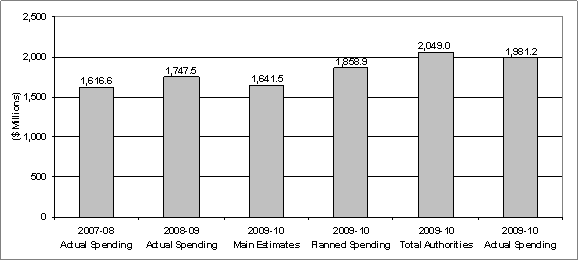
Financial Analysis
The Department's total actual spending for 2009-10 was $1,981.2 million. Spending generally increased between 2004-05 and 2009-10.
Planned Spending to Total Authorities: From $1,858.9 Million to $2,049.0 Million
Planned spending for 2009-10 was $1,858.9 million, whereas the Total Authorities for the Department are $2,049.0 million, representing a change of $190.1 million. The increase is primarily due to:
- $63.7 million for salary expenditures related to approved collective agreements and other associated benefits;
- $42.7 million in net additional funding for items such as financial support for Quebec and Atlantic lobster harvesters, assessment, management and remediation of Federal Contaminated Sites, the design phase of Canadian Coast Guard mid-shore patrol vessels, policing and security at the 2010 Olympic and Paralympic Winter Games, and support for continuing negotiations of land claims and First Nations' self-government in British Columbia;
- $35.4 million from deferred spending carried forward from 2008-09 for the operating budget carry forward ($26.4 million), and the Canadian Coast Guard special non-lapsing capital carry forward ($9 million);
- $26.1 million for Economic Action Plan initiatives led by other government departments for items such as modernizing federal laboratories, environmental assessments for the Mackenzie Gas Project, and accelerated remediation of federal contaminated sites;
- $19.0 million for statutory adjustments; and
- $3.2 million related to the sale of Crown assets.
Total Authorities to Actual Spending: From $2,049.0 Million to $1,981.2 Million
The difference of $67.8 million is largely explained by:
Funds not spent:
- $45.9 million in operating, capital, and grants and contributions spending that was deferred and carried forward to future years for such initiatives as the Pacific Integrated Commercial Fisheries Initiative, the Atlantic Lobster Sustainability Measures program, the operating budget carry forward, and the Canadian Coast Guard special non-lapsing capital carry forward.
- $7.1 million in lapsing appropriations primarily due to an amount frozen to offset a forecast shortfall in revenue.
- $5.1 million in employee benefit premiums that are charged when funds are transferred from operating expenditures to cover salary costs.
- $1.6 million to refund previous years' revenue.
- $11.0 million in general lapses - that is, funds the Department did not spend. These include items such as $1.4 million in operating and capital funds that are not eligible to be carried forward to future years and lower than expected interest in available grants and contributions funding for the Pacific Integrated Commercial Fisheries Initiative and the Atlantic Lobster Sustainability Measures programs.
Additional funds received:
- $3.0 million released from frozen allotments, in lieu of new appropriations, primarily to fund Canadian Coast Guard security activities at the 2010 Olympic and Paralympic Winter Games.
DFO carried forward $45.9 million of this $67.8 million for spending in future years. Only $21.8 million, approximately 1% of total approved spending authority, remained unspent and was lapsed. This highlights the accuracy of the Department's financial management.
Spending by Strategic Outcome
The Department's total actual spending was $1,981.2 million in 2009-10. Spending associated with the Safe and Accessible Waterways strategic outcome accounted for approximately 50% of all spending. Approximately 54% of total departmental spending was due to two programactivities: the Canadian Coast Guard (37%) and Fisheries Management (17%). Science Program activities associated with the three strategic outcomes accounted for 12% of the Department's total spending.
Operating expenditures made up 73% of DFO's spending in 2009-10.
Capital spending formed the next largest share (21%) of actual spending. Coast Guard spending on vessel infrastructure accounted for approximately 58% of capital spending. Expenditures on Small Craft Harbours made up another 24%, improvements in DFO real property assets for most of the remainder (16%).
Grants and contributions, or transfer payments, are monetary payments or transfers of goods, services, or assets to third parties. Transfer payments include grants, contributions, and other transfer payments, including those made to other orders of government, international organizations, and First Nations. Grants and contributions account for approximately 6% of the Department's spending.
DFO uses twelve major (over $500,000 per year) transfer payment programs, as well as a number of smaller programs, to leverage its resources and to achieve program and policy objectives associated with its three strategic outcomes. Of these, six account for almost 85% of the Department's grants and contributions.
Canada's Economic Action Plan
Canada's Economic Action Plan (EAP) allocates close to $12 billion in new infrastructure funding over two years to create jobs across Canada and to ensure that Canada emerges from the economic downturn with a more modern and greener infrastructure. DFO received the following funding in 2009-10 as part of the government's EAP.
| EAP Initiative | Summary of Performance | 2009-10 | ||
|---|---|---|---|---|
| Forecast Spending | Actual Spending | Actual Spending, including Contributions to Employee Benefit Plans | ||
| Canadian Coast Guard - Shipbuilding and Repair |
|
90.0 | 81.9 | 82.1 |
| Small Craft Harbours |
|
102.3 | 112.3* | 116.9 |
| Pangnirtung Harbour |
|
7.0 | 4.2 | |
| Mackenzie Gas Project |
|
4.2 | 3.6 | 3.9 |
| Federal Laboratories |
|
13.6 | 13.1 | 13.1 |
| Federal Contaminated Sites Action Plan |
|
8.2 | 8.6 | 8.7 |
| Total | 225.3 | 223.7 | 224.7 | |
* Small Craft Harbours spent $8 million in unused funding from Canadian Coast Guard and $2.8 million of unused funding from Pangnirtung Harbour in 2009-10. This funding will be returned to Canadian Coast Guard and Pangnirtung Harbour in 2010-11.
Additional information can be found electronically on the Canada's Economic Action Plan website.
Economic Action Plan Spending
- Date modified:
